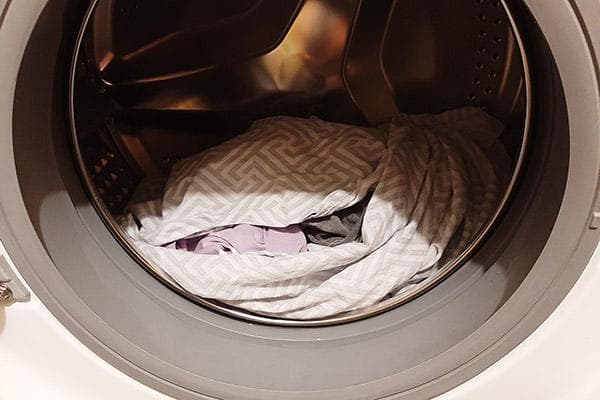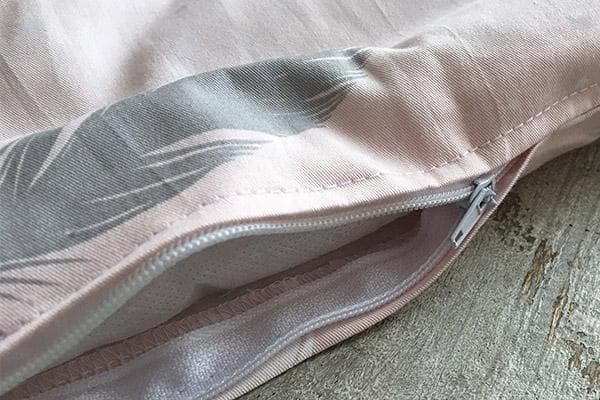How to wean a duvet cover from absorbing laundry during washing
Some housewives regularly face a problem: when washing, laundry gets stuck in the duvet cover. Let's try to figure out why this happens and whether there are methods that allow us to avoid such incidents.

Why does laundry end up inside the duvet cover?
There is no magic in the fact that pillowcases and sheets end up inside the duvet cover. This phenomenon has a completely material basis. Or rather, a few basics:
- Firstly, it all depends on the design of the drum and the washing system. If the water inside the machine splashes very actively, vortices and jets arise, which immediately pick up lighter things and move them in different planes. It is not possible to do the same with a duvet cover: it is too heavy. But one part of it - the slot - still turns out to be too tough for the water. The waves separate the two layers of fabric, and everything that happens next is quite natural - small towels, pillowcases and sheets fall into the “open mouth” of the duvet cover. Next, the tank makes a turn, the “jaws” close, and the duvet cover “swallows” everything that is inside it.
- Secondly, the fabric from which the duvet cover is made matters. More slippery materials (eg silk, polyester) are not as susceptible to water turbulence. Natural, and even heavy fabrics - linen, cotton - are highly likely to absorb everything that is nearby.Fun fact: if you put two duvet covers in the drum, one of which is thin silk and the other thick and cotton, then by the end of the wash the first will be inside the second.
Effect on the washing process
It cannot be said that getting other things inside the duvet cover somehow affects the quality of the wash. Powders and gels dissolve in water, and the fabrics from which bedding is made have good water permeability. A normal cycle of 40–60 minutes is enough to remove all kinds of contaminants from the material.
Problems can arise in two cases:
- when there are stubborn stains on things - to get rid of them, the laundry needs to be soaked in special solutions with bleaches, solvents or enzymes;
- if the person who uses the bedding is prone to allergic reactions. The fact is that the more densely the laundry is crumpled, the worse microparticles of washing powder are rinsed out of it. The solution may be to use hypoallergenic products, which, even if they remain between the fibers of the fabric, will still not cause harm to health.
Solution
Most often, housewives resort to radical measures - they sew up the “mouth” of the duvet cover. This is effective, but impractical - if you have to wash several sets of clothes, then sitting with a needle in your hands will take about an hour. But then you still have to undo the threads to tuck in the blanket.
A faster method involves using rubber bands. The side of the duvet cover on which the slot is located is folded like an accordion and rewound into several wraps. This is faster than sewing, but there is a risk that during the washing process the elastic will burst and get stuck in the drain hose or create a clog in the drain.If this happens, you will have to disassemble and clean the machine yourself or call a technician (of course, not for free).
There are also safe methods:
- Sew buttons with eyelets to the slit or sew in a zipper. This design helps not only during washing - it also prevents the blanket from slipping out of its “clothing” when a person actively turns over in his sleep.
- Buy special laundry bags - they are made of the finest but strong mesh, which allows water to pass through perfectly, but prevents the duvet cover from absorbing the rest of the contents of the drum.
Summarizing the above, it can be argued that the washing machine is to blame for “eating” things. So, you can avoid such situations even at the stage of choosing this home assistant - just ask your friends what models of “washing machines” they use and whether they have observed the “hungry duvet cover” effect. However, if you are not yet planning to purchase new equipment, it is enough to improve the bed linen itself by attaching fasteners to the slots.


tie the slit with white thread (like the neck of a bag) - it’ll take a minute... the rest of the methods are nonsense..
It is better to sew a ribbon to the inside of the duvet cover so that the ribbons do not dangle from the outside.
And this is truly the most convenient way.
In my opinion, this is the worst way to tie anything at the neck. A lot of the fabric will be crumpled and tied, which will not allow everything to be washed well. Dirty streaks may also appear inside the folds.
They told me to bandage it with a thin handkerchief, it’s very convenient and stress-free, everything washes together, try it.
Sew regular buttons
I tie the hole with an elastic band and no problems.
Regular pins solve the problem. No buttons, no elastic bands, no ribbons needed. Tested many times and not a single failure
fold the duvet cover 4 times and pin it in the corners and in the middle of the edges with several layers.
And we stopped using duvet covers a long time ago. There are now many types of blankets, made of different materials.
I have Bosch and the same problem with the duvet cover. Now I'll come up with something.
I sewed several bags from old tulle with a drawstring and when I wash sheets, duvet covers, bath towels, I put them in the bags and wash them without problems. Everything is washed and rinsed well. I've been using this for many years.
The easiest way to buy duvet covers is with a zipper.
How does it suck? I have a zipper on every duvet cover.
I fold it with the slit facing inwards.This is the size of an average towel. Then I spread it over the tank. I put something small on top.
I tie the duvet cover folded diagonally with a loose, weak, large knot.
I just tie the duvet cover with a loose knot. And small things in a mesh bag and everything in a drum!
I use the most ordinary plastic clothespins with an aluminum spring: 3-4 pieces per duvet cover hole and no problems. I also fasten pillowcases without a zipper.
I USE regular pins and no problems
I had this problem before, it was really annoying) in the new Hotpoint washing machine this doesn’t happen anymore, finally)
I use top-loading machines and never get anything into my duvet cover!
I sew up duvet covers and pillowcases! And it takes not an hour, but 5 minutes. No need to secure the seam with a knot, just leave the thread longer. And you don’t need to try - a few large stitches in the middle of the slot and you’re good. For washed items, simply pull out the thread; no need to rip anything out.
and I wash the duvet covers separately and that’s it!
I sewed on a couple of buttons and made the same number of loops. It took twenty minutes.
I use ribbons made from cotton fabric/I cut them from old bed linen/. I also tie a folded double sheet together. I add a sheet, duvet cover and other small things to balance the machine
I haven’t used duvet covers for a long time; I buy bedspreads and blankets.
Stationery clip! 1 piece in the middle of the slot! 30 seconds and done
Great and easiest way, thanks for the advice!
You need to wet the duvet cover and then put it in the machine.
I wash my duvet covers alone.If you cram anything else in with it, there won’t be enough space in the washing machine, and everything won’t be rinsed out well. Still, 12 square meters of not the thinnest fabric is not the lightest and least voluminous.
Make 2-3 fastenings with a stapler.
What a sexist site, everything is addressed only to women (HOUSEWIFE!), even the basic act of putting laundry into a washing machine. Your callous morals are hopelessly outdated, dear ones.
I put 2 duvet covers but they managed to fit into each other
And if you think with your head, then it is better to wash the duvet cover separately from the small items. There won't be any problems
Now I put the duvet cover in a special laundry bag and no problems.